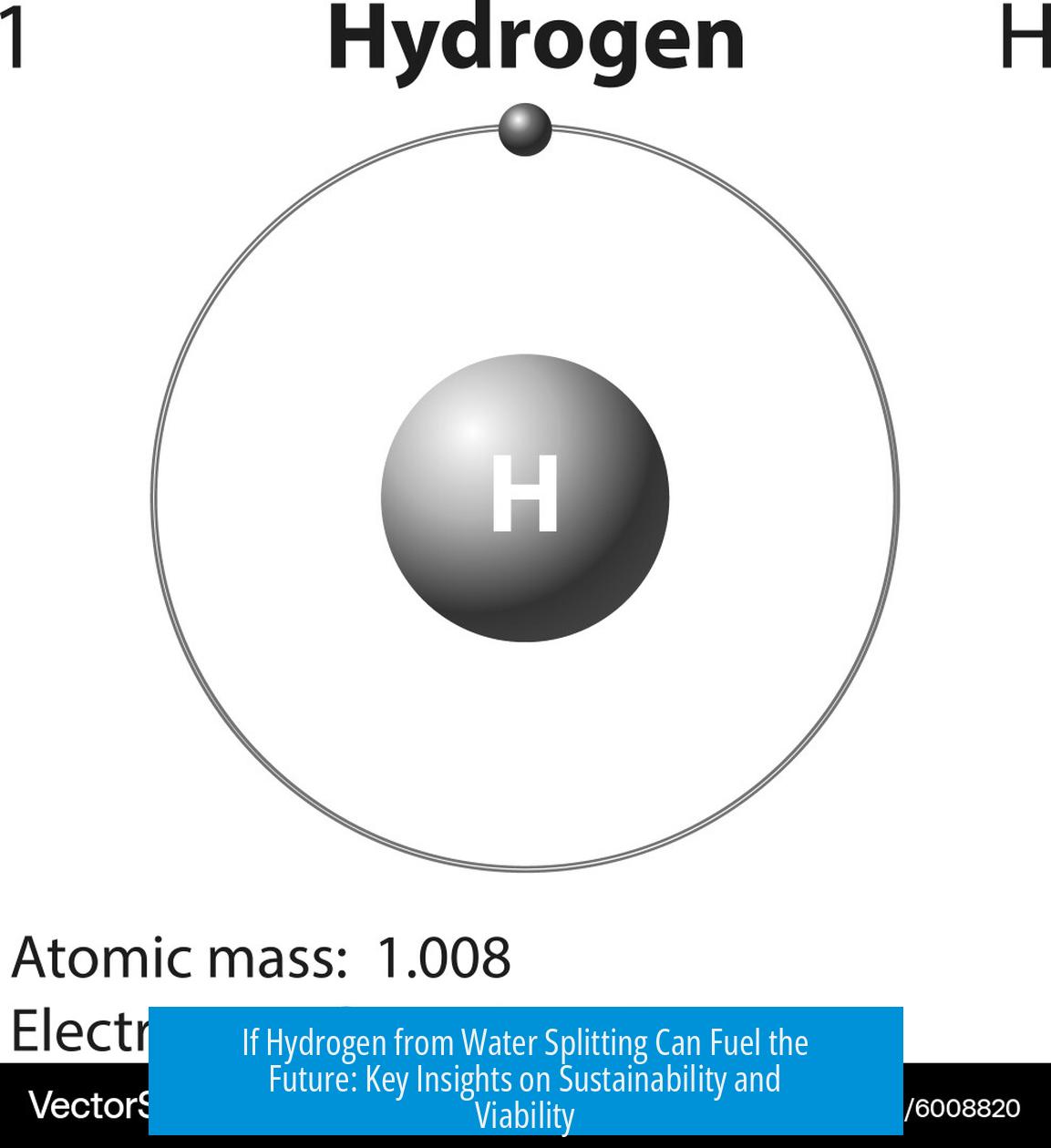If Hydrogen Is Made from Splitting Water, How Can It Be a Useful Fuel in the Long Term?
Hydrogen produced by splitting water functions primarily as an energy storage medium rather than a primary energy source. It allows for the storage and transport of renewable or low-carbon energy, helping to balance intermittent supply from sources like solar and wind. Despite inherent thermodynamic inefficiencies, hydrogen’s long-term utility lies in its zero-carbon emissions upon use, compatibility with existing infrastructure, and role in sectors where direct electrification is challenging.
Hydrogen: Energy Storage, Not Creation
Hydrogen does not generate energy independently. The energy it carries must come from an external source, such as solar, wind, nuclear, or hydroelectric power. In this sense, hydrogen acts like a battery, storing energy in chemical form to be released later through combustion or fuel cells.
- Uses electricity to split water into hydrogen and oxygen via electrolysis.
- Stores surplus renewable energy that would otherwise go unused.
- Delivers portable energy suitable for transport, industrial, or heating applications.
By storing energy chemically, hydrogen addresses a core limitation of renewable energy: variability. Sunlight and wind are intermittent, making direct consumption challenging. Hydrogen can store excess generation during peak periods and release it when demand is high.
Thermodynamics and Efficiency Constraints
Producing hydrogen via water splitting requires energy input exceeding the energy output from burning hydrogen. This is due to thermodynamic principles, particularly entropy and energy conversion inefficiencies.
- Electrolysis efficiency can reach up to 98% under optimal conditions but practical systems are somewhat lower.
- Fuel cells converting hydrogen back into electricity exhibit efficiencies around 40-80%, depending on type and temperature.
- The full hydrogen energy cycle (production, storage, use) has losses but still offers value in certain contexts.
No fuel generation process delivers a net energy gain. Fossil fuels also require energy to extract and process. Thus, hydrogen should be viewed as an energy carrier, moving energy from sources to consumers rather than creating it.
Current and Potential Methods for Hydrogen Production
Today, most hydrogen (around 96%) is produced via steam methane reforming (SMR), which uses fossil fuels and emits CO2. Green hydrogen, by contrast, originates from electrolysis powered by renewables or nuclear, resulting in zero direct emissions.
- Steam reforming: Converts methane and water to hydrogen and carbon monoxide; carbon footprint depends on natural gas source.
- Electrolysis: Uses electricity to split water molecules; carbon-neutral if powered by renewable energy.
- Emerging methods: Photocatalysis directly uses sunlight to split water, potentially increasing efficiency and lowering costs.
- Biomass and methane reforming: Alternative pathways being explored for sustainable hydrogen.
Increasing economic viability and environmental pressure push development toward green hydrogen production technologies.
Role in a Sustainable, Low-Carbon Energy System
Hydrogen complements electrification by providing fuel options for sectors less suited to direct electricity use:
- Long-distance transport where battery weight and range limits exist.
- Industrial processes requiring high heat or specific chemical properties.
- Heating systems where retrofitting for electricity is costly.
Its compatibility with existing gas infrastructure and appliances makes hydrogen a transitional or supplementary fuel. It facilitates the use of surplus renewable electricity and supports decarbonization of hard-to-electrify areas.
Challenges to Long-Term Viability
Several factors complicate hydrogen’s widespread adoption:
- Storage and transport: Hydrogen has low volumetric energy density, requires high pressure or liquefaction, and leaks easily.
- Safety concerns: It is highly flammable and can embrittle metals, demanding rigorous management.
- Cost: Production, storage, and infrastructure remain expensive, especially for green hydrogen.
- Infrastructure: Existing gas networks require modification; refueling stations are limited.
- Fuel cell materials: Dependence on precious metal catalysts limits scale and raises costs.
These challenges mean hydrogen will not replace electricity but coexist as part of an integrated energy system.
Key Applications Demonstrating Hydrogen’s Long-Term Utility
Hydrogen’s properties suit specific uses:
| Application | Reason for Use | Notes |
|---|---|---|
| Rocket Fuel | High specific impulse; energy dense | Preferred for rapid, high-energy release in space missions |
| Stationary Energy Storage | Stores excess renewable electricity for later use | Balances grid fluctuations and supports renewables integration |
| Industrial Feedstock | Produces chemicals like ammonia or reduces metals | Enables greener production in chemicals and materials |
| Transport Fuel (Fuel Cells) | Zero tailpipe emissions; faster refueling | Challenges with efficiency and cost remain |
Hydrogen Energy Cycle and System Integration
The hydrogen cycle closes loop with water: splitting water yields hydrogen and oxygen, recombining them produces water and energy. Still, external energy is needed to initiate splitting.
View hydrogen as a rechargeable battery:
Use 100 units of energy from renewables → produce hydrogen → store hydrogen → release ~80-90 units of usable energy → accept loss as opportunity cost for clean storage.
This cycle depends entirely on sourcing low-carbon electricity to maintain climate benefits.
Key Takeaways
- Hydrogen from water splitting is an energy carrier, not a source; energy input comes from renewables or nuclear power.
- Thermodynamic limits cause energy losses but storage capabilities offer critical flexibility for renewable systems.
- Green hydrogen production remains costly but reduces carbon footprint compared to fossil-derived hydrogen.
- Hydrogen excels in transport, industrial processes, stationary storage, and sectors difficult for electrification.
- Safety, storage, and infrastructure challenges require ongoing technological and policy solutions.
- Long-term utility hinges on sustainable hydrogen production and integration with evolving energy systems.
1. Why is hydrogen useful as a fuel if splitting water wastes energy?
Hydrogen stores energy produced elsewhere, like solar or wind. It acts like a battery, holding energy for later use. Even though splitting water uses energy, hydrogen helps use excess renewable power that might otherwise be lost.
2. How does hydrogen help with renewable energy’s unpredictability?
Renewables don’t always produce power on demand. Hydrogen stores surplus energy so it can be used when production drops. This balances the gaps in wind or solar availability and reduces reliance on expensive battery storage.
3. Can hydrogen made by splitting water really be carbon neutral?
Yes, if the electricity used to split water comes from renewable or nuclear sources, hydrogen production emits almost no carbon. This “green hydrogen” can replace fossil fuels in hard-to-electrify areas, lowering overall emissions.
4. What are the main limitations of using hydrogen stored from water?
Hydrogen storage requires high pressure or low temperature, and it leaks easily. It also weakens metals and is flammable. These factors make storage and transport challenging compared to liquid fuels or batteries.
5. How efficient is hydrogen fuel compared to direct electricity use?
Hydrogen production and use involve energy losses, so it’s less efficient than using electricity directly. However, it is valuable where direct electrification isn’t practical, serving as a bridge to cleaner energy systems over time.
6. Is hydrogen compatible with existing energy infrastructure?
Hydrogen can adapt to current technology, like converting natural gas boilers. It can also be used to produce chemicals with fewer emissions. This compatibility supports gradual transition toward low-carbon fuels.





Leave a Comment